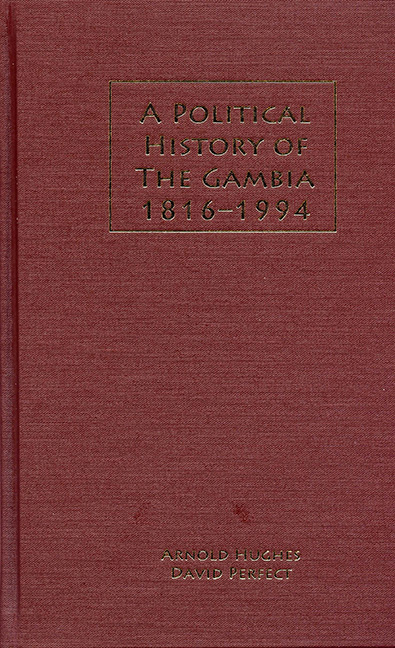Book contents
- Frontmatter
- Dedication
- Map
- Contents
- List of Tables
- List of Interviewees
- Acknowledgments
- Abbreviations
- Introduction
- 1 Social and Economic Setting
- 2 Constitutional Change in The Gambia, 1816–1994
- 3 Merchants and Recaptives: The Origins of Modern Politics, 1816–86
- 4 Patrician Politics in the Era of the Forsters, 1886–1941
- 5 The Establishment of Party Politics, 1941–59
- 6 The “Green Uprising”: The Emergence of the People's Progressive Party, 1959–65
- 7 Electoral Politics, 1965–81
- 8 Radical and Insurrectionary Political Challenges, 1965–81
- 9 Electoral Politics, 1981–94
- 10 The Gambia's External Relations, 1965–94
- 11 The 1994 Coup and the Jawara Legacy
- Appendix A Major Constitutional Changes, 1816–1994
- Appendix B Legislative Council Election Results, 1947–54
- Appendix C General Election and By-Election Results, 1960–93
- Appendix D Presidential Election Results, 1982–92
- Appendix E Republic Referendum Results, 1970
- Appendix F Primary Sources
- Appendix G Newspapers and Magazines Consulted
- Notes
- Bibliography
- Index
- Rochester Studies in African History and the Diasora
1 - Social and Economic Setting
Published online by Cambridge University Press: 13 April 2017
- Frontmatter
- Dedication
- Map
- Contents
- List of Tables
- List of Interviewees
- Acknowledgments
- Abbreviations
- Introduction
- 1 Social and Economic Setting
- 2 Constitutional Change in The Gambia, 1816–1994
- 3 Merchants and Recaptives: The Origins of Modern Politics, 1816–86
- 4 Patrician Politics in the Era of the Forsters, 1886–1941
- 5 The Establishment of Party Politics, 1941–59
- 6 The “Green Uprising”: The Emergence of the People's Progressive Party, 1959–65
- 7 Electoral Politics, 1965–81
- 8 Radical and Insurrectionary Political Challenges, 1965–81
- 9 Electoral Politics, 1981–94
- 10 The Gambia's External Relations, 1965–94
- 11 The 1994 Coup and the Jawara Legacy
- Appendix A Major Constitutional Changes, 1816–1994
- Appendix B Legislative Council Election Results, 1947–54
- Appendix C General Election and By-Election Results, 1960–93
- Appendix D Presidential Election Results, 1982–92
- Appendix E Republic Referendum Results, 1970
- Appendix F Primary Sources
- Appendix G Newspapers and Magazines Consulted
- Notes
- Bibliography
- Index
- Rochester Studies in African History and the Diasora
Summary
Chapter 1 provides the socioeconomic context to the political events analyzed in subsequent chapters. A physical description of The Gambia is provided first, followed by a review of the available demographic data and a description of the major ethnic groups of the country. Religious beliefs, educational development, and the labor force are then examined from a historical perspective. Finally, the structure of the economy is outlined and its prosperity (or otherwise) assessed chronologically.
Physical Description
The Gambia is one of the smallest countries in Africa, having a total area of approximately 11,000 square kilometers (4,361 square miles). It consists of strips of land about 10 kilometers wide (about 6 miles) either side of the River Gambia (one of the most navigable rivers in West Africa) and extends 470 kilometers (292 miles) into the interior of Africa from the Atlantic Ocean. A former British colony, it was known as either “Gambia” or “the Gambia” until independence in 1965; to avoid confusion, we have used the former term when referring exclusively to the colonial period. The Gambia's northern, eastern, and southern borders, which are all shared with Senegal, were defined by a wide-ranging Anglo-French Convention of 1889 and demarcated between 1891 and 1905 (its eastern border was slightly modified in 1976).
The 1889 treaty with France considerably expanded the size of Gambia. The British Crown Colony consisted of a few scattered settlements along the River Gambia with an estimated total area of only 110 square kilometers (69 square miles). St. Mary's Island at the mouth of the river, on which the capital, Bathurst (now Banjul) was located, was purchased in 1816; MacCarthy Island, 241 kilometers (150 miles) up river, was acquired in 1823; the “Ceded Mile,” a tract of land on the north bank of the river 1.6 kilometers (1 mile) in breadth and 58 kilometers (36 miles) in length, was ceded in 1826 (and extended in 1832); British Kombo (which was later called Kombo St. Mary), an area of 40 square kilometers (25 square miles) to the west of Bathurst was ceded in 1840 (and extended in 1853); Albreda, a trading post on the north bank of the river, was exchanged by France in 1857; and a few other districts were annexed in the 1880s.
- Type
- Chapter
- Information
- A Political History of the Gambia, 1816–1994 , pp. 6 - 40Publisher: Boydell & BrewerPrint publication year: 2006

